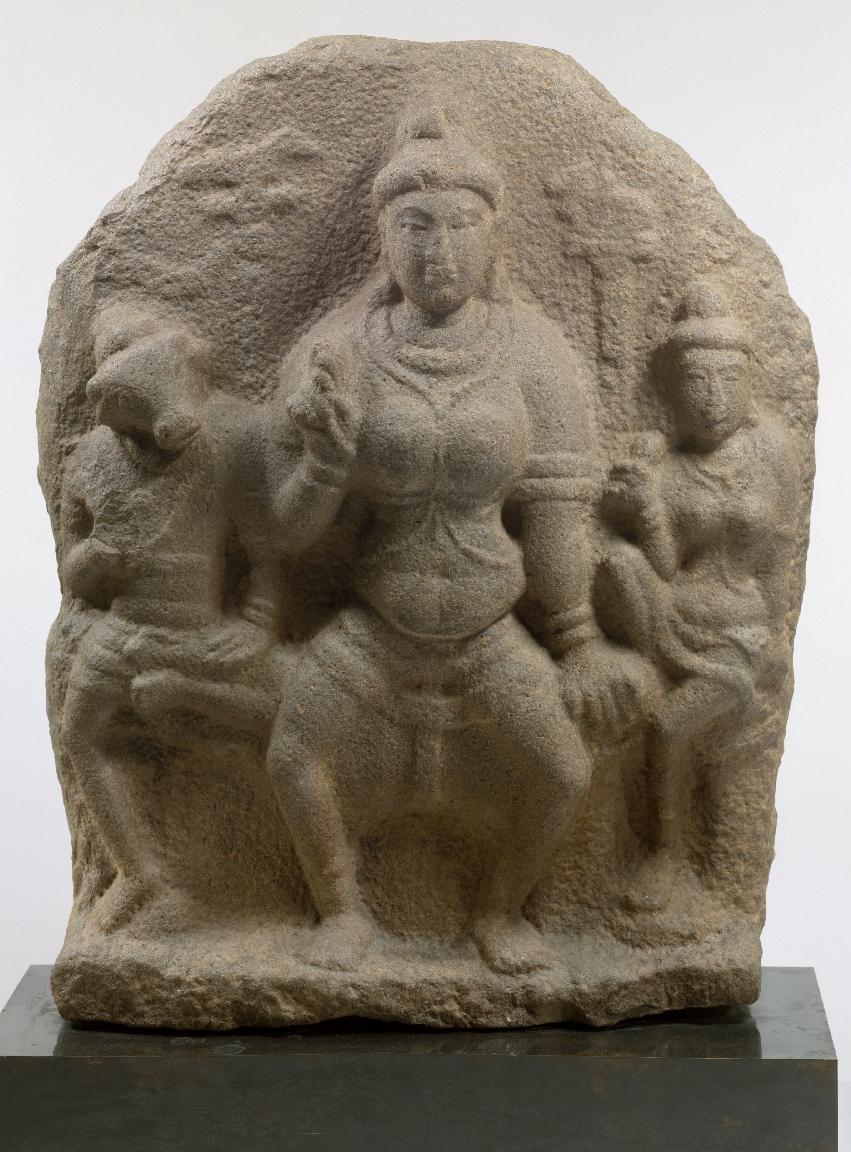
The Chola (300 BC-1279 AD)

Figure 1.--This relief fragment pictures Jyestha, the goddess of bad fortune, a major cult developed around her in the Chola culture. She is flanked by her children and her children, her daughter and her bull-headed son who holds a club. The fragment dates to the period in which the Chola were becoming a major force (9-10th century AD). We have been unable to find much imagery from the Chola, despite its long history. Give its locus in souther India, we suspect that children and even adults because of the warm climate did not wear a lot of clothes. While the relief provides few details, it suggests that mother and the children were dressed very similarly. Source: Metropolitan Museum of Art (New York).
|
|
The Chola culture was the principal Tamil state of southern India. It existed for over a millenium, although the territory and importance varied greatly over time. The Chola extended both theough the anchientb and medieval era, although their golden age was during the medieval era bfore the arival of the Moguls and Europeans. The early history is not well documented, but inscriptions from the left by Asoka of the Maurya Empire mntion the Chola (3rd century BC). Chola was one of the three croned Tamil kings ( Chola, Chera and Pandya) which dominated the ancient Tamil lands. Medieval India was dominated by the Choula in the south and the Rajputs in the north. The most important dynasty during the medieval rose in southern India away from the Indus Valley in the north where civilization first appeared during the ancient era. The Cholas unlike other mahor dynasties (the Chalukyas, the Pallavas, the Pandyas or the Rashtrakutas) were a native dynasty not an invaduing force. The Deccan region was in chaos. The Deccan Plateau comprises much of southern Asia. The Cholas reduced the Pallavas to the status of minor vassals. The Rashtrakutas had declined, but a resurgent branch of the Chalukya family (the later Chalukyas) became an imortant regionalpower in the western Deccan. The Deccan region was contested by the later Chalukyas, the Yadavas in Devagiri (northern Deccan around Aurangabad), the Kakatiyas of Warangal (Andhra Pradesh) and the Hoysalas of Dorasamudra (Mysore). It was Cholas who ultimarely merged as unchallenged authorities in the south (900-1100 AD).
The Chola heartland was the fertile Kaveri valley, but the Chola expanded over much of southern India at its peak. The Chola controlled India south of the Tungabhadra which they united for two and a half centuries and more. The Chola under Rajaraja Chola I and his son Rajendra Chola I, the became a dominant military, economic and cultural power throughout South Asia and projecting power into Southeast Asia. There were military expeditions north to the Ganges conducted by Rajendra Chola I, They occupied the maritime cities of Srivijaya. Chinese records report embassies from Chola. At its peak the Chola Empire extended from the islands of the Maldives in the south to as far north as the banks of the Godavari River in Andhra Pradesh (1010-1200). Rajaraja Chola was the great warrior king of the Chola. It was he who conquered peninsular South India, annexed parts of the island of Ceylon/Sri Lanka,and the Maldives. Rajendra Chola even mounted military expedition to North India, reaching Ganges and defeated the Pala ruler of Pataliputra, Mahipala. The Chola then began to decline (early-13yj century). The rise of the Pandyas spelled the end of the Chola. The Chola are best known for their literature and architecture. Th Chola kings were great builders. The temples they built were designed as both religious and commercial centers. Tgeynalso left important works of Tamil literature. The Chola pioneered centralised government in South Asia and governed through a trained bureaucracy. Their influence to the eastcan be seen in the Malay chronicle 'Sejahrah Melayu' which reports that the rulers of the strategically placed Malacca Sultanate far to the east claimed to be descendants of the Chola Empire.
HBC

Navigate the Boys' Historical Clothing Web Site:
[Introduction]
[Activities]
[Biographies]
[Chronology]
[Clothing styles]
[Countries]
[Topics]
[Bibliographies]
[Contributions]
[FAQs]
[Glossaries]
[Images]
[Links]
[Registration]
[Tools]
[Boys' Clothing Home]
Navigate the Boys' Historical Clothing national pages:
[Return to the Main ancient Indian history page]
[Return to the Main Indian history page]
[Return to the Main countries page]
[Australia]
[Belgium]
[China]
[England]
[France]
[Germany]
[India]
[Indonesia]
[Ireland]
[Italy]
[Japan]
[Korea]
[Malaysia]
[Mexico]
[The Netherlands]
[Pakistan]
[Portugal]
[Scotland]
[Spain]
[United States]
Created: 6:40 PM 12/12/2013
Last updated: 6:40 PM 12/12/2013



